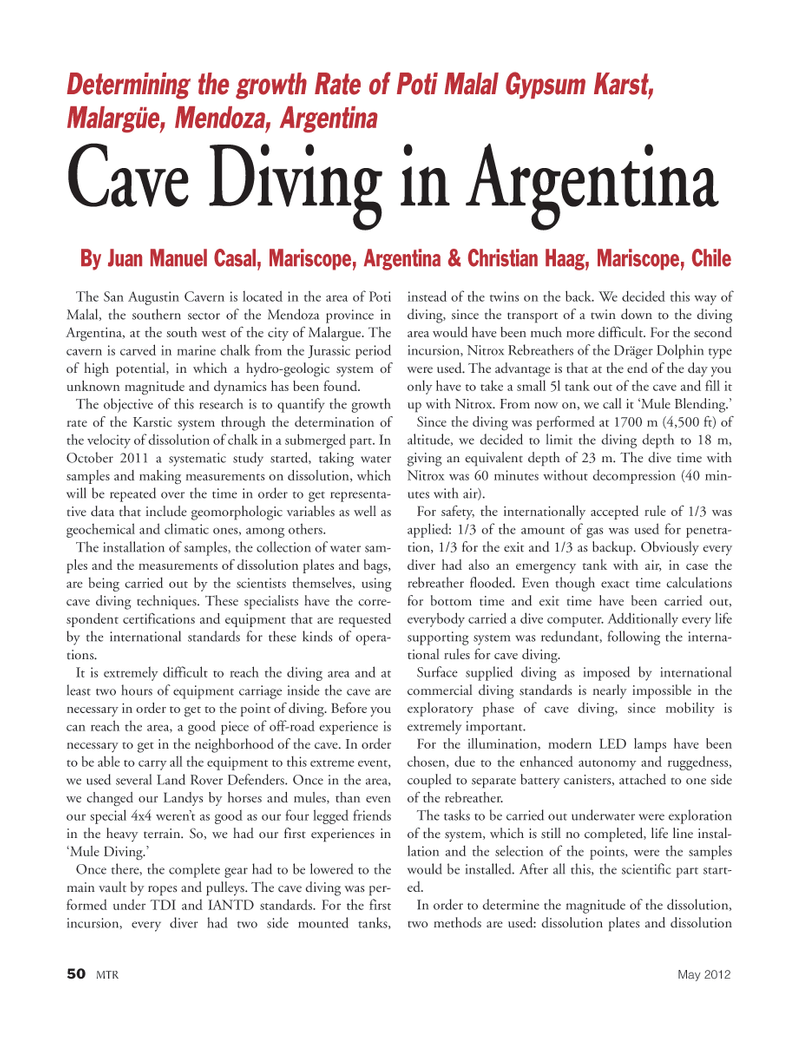
Page 50: of Marine Technology Magazine (May 2012)
Hydrographic Survey
Read this page in Pdf, Flash or Html5 edition of May 2012 Marine Technology Magazine
50MTRMay 2012The San Augustin Cavern is located in the area of Poti Malal, the southern sector of the Mendoza province in Argentina, at the south west of the city of Malargue. The cavern is carved in marine chalk from the Jurassic period of high potential, in which a hydro-geologic system of unknown magnitude and dynamics has been found. The objective of this research is to quantify the growth rate of the Karstic system through the determination of the velocity of dissolution of chalk in a submerged part. In October 2011 a systematic study started, taking water samples and making measurements on dissolution, which will be repeated over the time in order to get representa- tive data that include geomorphologic variables as well as geochemical and climatic ones, among others.The installation of samples, the collection of water sam-ples and the measurements of dissolution plates and bags, are being carried out by the scientists themselves, using cave diving techniques. These specialists have the corre- spondent certifications and equipment that are requested by the international standards for these kinds of opera- tions.It is extremely difficult to reach the diving area and at least two hours of equipment carriage inside the cave are necessary in order to get to the point of diving. Before you can reach the area, a good piece of off-road experience is necessary to get in the neighborhood of the cave. In order to be able to carry all the equipment to this extreme event, we used several Land Rover Defenders. Once in the area, we changed our Landys by horses and mules, than even our special 4x4 weren?t as good as our four legged friends in the heavy terrain. So, we had our first experiences in ?Mule Diving.? Once there, the complete gear had to be lowered to the main vault by ropes and pulleys. The cave diving was per- formed under TDI and IANTD standards. For the first incursion, every diver had two side mounted tanks, instead of the twins on the back. We decided this way of diving, since the transport of a twin down to the diving area would have been much more difficult. For the second incursion, Nitrox Rebreathers of the Dräger Dolphin type were used. The advantage is that at the end of the day you only have to take a small 5l tank out of the cave and fill it up with Nitrox. From now on, we call it ?Mule Blending.? Since the diving was performed at 1700 m (4,500 ft) of altitude, we decided to limit the diving depth to 18 m, giving an equivalent depth of 23 m. The dive time with Nitrox was 60 minutes without decompression (40 min- utes with air).For safety, the internationally accepted rule of 1/3 was applied: 1/3 of the amount of gas was used for penetra-tion, 1/3 for the exit and 1/3 as backup. Obviously every diver had also an emergency tank with air, in case the rebreather flooded. Even though exact time calculations for bottom time and exit time have been carried out, everybody carried a dive computer. Additionally every life supporting system was redundant, following the interna- tional rules for cave diving. Surface supplied diving as imposed by international commercial diving standards is nearly impossible in the exploratory phase of cave diving, since mobility is extremely important. For the illumination, modern LED lamps have been chosen, due to the enhanced autonomy and ruggedness, coupled to separate battery canisters, attached to one side of the rebreather. The tasks to be carried out underwater were exploration of the system, which is still no completed, life line instal-lation and the selection of the points, were the samples would be installed. After all this, the scientific part start- ed.In order to determine the magnitude of the dissolution, two methods are used: dissolution plates and dissolution Determining the growth Rate of Poti Malal Gypsum Karst,Malargüe, Mendoza, ArgentinaCave Diving in Argentina By Juan Manuel Casal, Mariscope, Argentina & Christian Haag, Mariscope, Chile MTR#4 (50-64):MTR Layouts 5/7/2012 9:32 AM Page 50

 49
49

 51
51
